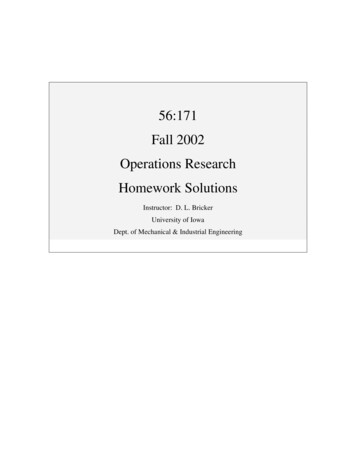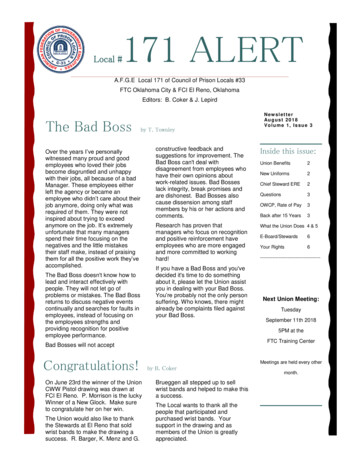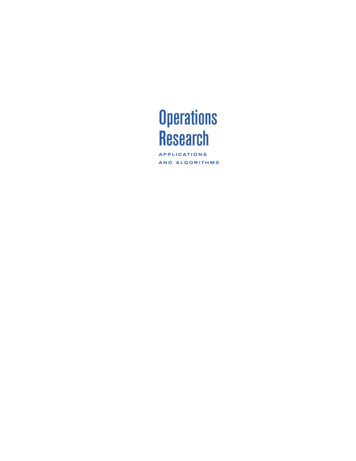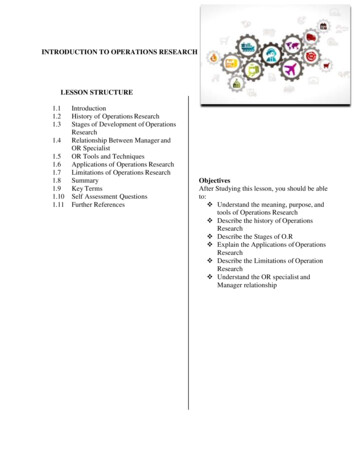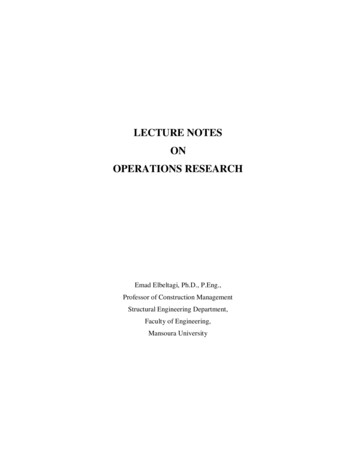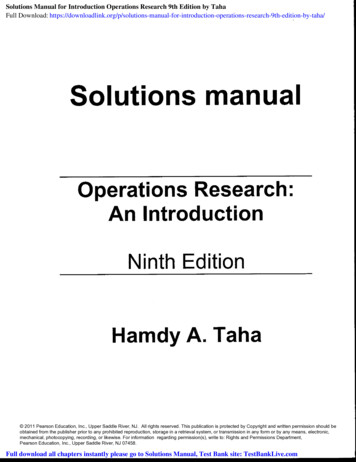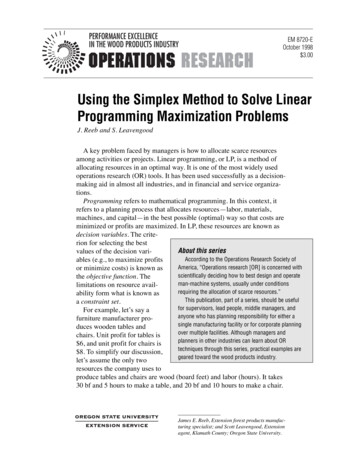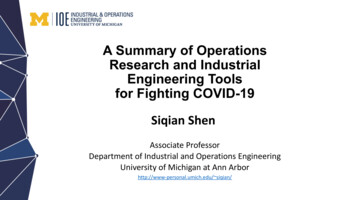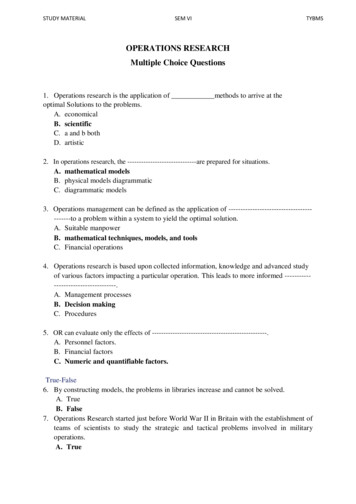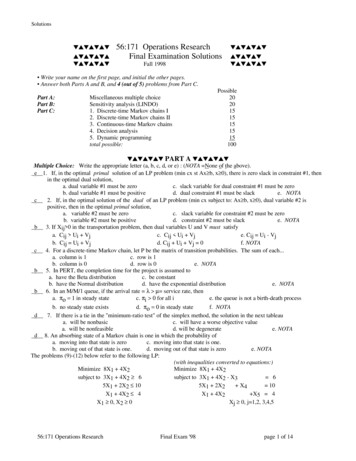
Transcription
Solutionststststststststststst56:171 Operations ResearchFinal Examination SolutionsFall 1998tststststststtststst Write your name on the first page, and initial the other pages. Answer both Parts A and B, and 4 (out of 5) problems from Part C.Part A:Part B:Part C:Miscellaneous multiple choiceSensitivity analysis (LINDO)1. Discrete-time Markov chains I2. Discrete-time Markov chains II3. Continuous-time Markov chains4. Decision analysis5. Dynamic programmingtotal possible:Possible20201515151515100tststst PART A tstststMultiple Choice: Write the appropriate letter (a, b, c, d, or e) : (NOTA None of the above).e 1. If, in the optimal primal solution of an LP problem (min cx st Ax b, x 0), there is zero slack in constraint #1, thenin the optimal dual solution,a. dual variable #1 must be zeroc. slack variable for dual constraint #1 must be zerob. dual variable #1 must be positived. dual constraint #1 must be slacke. NOTAc 2. If, in the optimal solution of the dual of an LP problem (min cx subject to: Ax b, x 0), dual variable #2 ispositive, then in the optimal primal solution,a. variable #2 must be zeroc. slack variable for constraint #2 must be zerob. variable #2 must be positived. constraint #2 must be slacke. NOTAb 3. If Xij 0 in the transportation problem, then dual variables U and V must satisfya. Cij Ui Vjc. Cij Ui Vje. Cij Ui - Vjb. Cij Ui Vjd. Cij Ui Vj 0f. NOTAc 4. For a discrete-time Markov chain, let P be the matrix of transition probabilities. The sum of each.a. column is 1c. row is 1b. column is 0d. row is 0e. NOTAb 5. In PERT, the completion time for the project is assumed toa. have the Beta distributionc. be constantb. have the Normal distributiond. have the exponential distributione. NOTAb 6. In an M/M/1 queue, if the arrival rate λ µ service rate, thena. πο 1 in steady statec. πi 0 for all ie. the queue is not a birth-death processf. NOTAb. no steady state existsd. πο 0 in steady stated 7. If there is a tie in the "minimum-ratio test" of the simplex method, the solution in the next tableaua. will be nonbasicc. will have a worse objective valuea. will be nonfeasibled. will be degeneratee. NOTAd 8. An absorbing state of a Markov chain is one in which the probability ofa. moving into that state is zeroc. moving into that state is one.b. moving out of that state is one.d. moving out of that state is zeroe. NOTAThe problems (9)-(12) below refer to the following LP:(with inequalities converted to equations:)Minimize 8X1 4X2Minimize 8X1 4X2subject to 3X1 4X2 6subject to 3X1 4X2 - X3 65X1 2X2 105X1 2X2 X4 10X1 4X2 4X1 4X2 X5 4X1 0, X2 0Xj 0, j 1,2, 3,4,556:171 Operations ResearchFinal Exam '98page 1 of 14
Solutionsa9 .The feasible region includes pointsa. B, F, & Gc. C, E, & Fb. A, B, C, & Fd. E, F, &Ge. NOTAd10. At point F, the basic variables include the variablesa. X2 & X3c. X4 & X5b. X3 & X4d. X1 & X4e. NOTAb11. Which point is degenerate in the primal problem?a. point Ac. point Cb. point Bd. point De. NOTAc12. The dual of this LP has the following constraints (not including nonnegativity or nonpositivity):a. 2 constraints of type ( )b. one each of type & c. 2 constraints of type ( )d. one each of type & e. None of the aboveb 13. The dual of the LP has the following types of variables:a. three non-negative variablese. three non-positive variablesb. one non-negative and two non-positive variablesf. None of the abovec. two non-negative variables and one unrestricted in signd. two non-negative variables and one non-positive variablee14. If point F is optimal, then which dual variables must be zero, according to the Complementary SlacknessTheorem ?a. Y1 and Y2d. Y1 onlyb. Y1 and Y3e. Y2 onlyc. Y2 and Y3f. Y3 onlyConsider a discrete-time Markov chain with transition probability matrix :.6 .4.3 .7ad15. If the system is initially in state #1, the probability that the system will be in state 2 after exactly one step is:a. 0.4c. 0.7e. none of the aboveb. 0.6d. 0.5216. If the Markov chain in the previous problem was initially in state #1, the probability that the system will still be instate 1 after 2 transitions isa. 0.36c. 0e. 0.52b. 0.60d. 0.48f. NOTA56:171 Operations ResearchFinal Exam '98page 2 of 14
Solutionscae17. The steady-state probability vector π of a discrete Markov chain with transition probability matrix P satisfies thematrix equationa. P π 0c. π (I-P) 0e. NOTAtb. P π πd. P π 018. For a continuous-time Markov chain, let Λ be the matrix of transition rates. The sum of each .a. row is 0c. row is 1e. NOTAb. column is 0d. column is 119. To compute the steady state distribution π of a continuous-time Markov chain, one must solve (in addition to sumof π components equal to 1) the matrix equation (where Λt is the transpose of Λ):a. π Λ 1c. Λ T π πe. π Λ 0Td. π Λ πf. NOTAb. Λ π 1e 20. Little's Law is applicable to queues of the class(es):a. M/M/1c. any birth-death processe. any queue with steady stateb. M/M/c for any cd. any continuous-time Markov chainf. NOTAe 21. In a birth/death model of a queue,a. time between arrivals has Poisson distributionb. number of "customers" served cannot exceed 1c. the distribution of the number of customers in the system has exponential distributiond. the arrival rate is the same for all statese. None of the abovetststst PART B tstststSensitivity Analysis in LP."A manufacturer produces two types of plastic cladding. These have the trade names Ankalor and Beslite. One yard ofAnkalor requires 8 lb of polyamine, 2.5 lb of diurethane and 2 lb of monomer. A yard of Beslite needs 10 lb of polyamine, 1lb of diurethane, and 4 lb of monomer. The company has in stock 80,000 lb of polyamine, 20,000 lb of diurethane, and30,000 lb of monomer. Both plastics can be produced by alternate parameter settings of the production plant, which is able toproduce sheeting at the rate of 12 yards per hour. A total of 750 production plant hours are available for the next planningperiod. The contribution to profit on Ankalor is 10/yard and on Beslite is 20/yard.The company has a contract to deliver at least 3,000 yards of Ankalor. What production plan should be implemented in orderto maximize the contribution to the firm's profit from this product division."Definition of variables:A Number of yards of Ankalor producedB Number of yards of Beslite producedLP model:1) Maximize 10 A 20 B subject to2)8 A 10 B 80,000(lbs. Polyamine available) 20,000(lbs. Diurethane available)3)2.5 A 1 B 30,000(lbs. Monomer available)4)2A 4B 9,000(lbs. Plant capacity)5)A B 3,000(Contract)6)AA 0, B 0The LINDO solution is:OBJECTIVE FUNCTION VALUE1) 5)6)REDUCED COST0.0000.000SLACK OR SURPLUS0.0006900.0001600.000400.0000.00056:171 Operations ResearchDUAL PRICES2.0000.0000.0000.000-6.000Final Exam '98page 3 of 14
SolutionsRANGES IN WHCH THE BASIS IS UNCHANGEDOBJ COEFFICIENT 003000.000THE TABLEAUROW(BASIS)1ART2B3SLK 34SLK 45SLK 56AROW123456A.000.000.000.000.0001.000SLK 66.0.8001.700-1.200.200-1.000RIGHTHAND SIDE .0002000.0001333.333B.0001.000.000.000.000.000SLK 22.000.100-.100-.400-.100.000SLK 3.000.0001.000.000.000.000SLK 4.000.000.0001.000.000.000SLK 5.000.000.000.0001.000.0000.14E 065600.0006900.0001600.000400.0003000.000Consult the LINDO output above to answer the following questions. If there is not sufficient information in the LINDOoutput, answer "NSI".c1. How many yards of Beslite should be manufactured?a. 3000 yardsc. 5600 yardse. NSIb. 1600 yardsd. 400 yardsc2. How much of the available diurethane will be used?a. 6900 poundsc. 13100 poundse. NSIb. 1600 poundsd. 400 poundsa3. How much of the available diurethane will be unused?a. 6900 poundsc. 13100 poundse. NSIb. 1600 poundsd. 400 poundsb4. Suppose that the company can purchase 2000 pounds of additional polyamine for 2.50 per pound. Should theymake the purchase? a. yesb. noc. NSIa5. Regardless of your answer in (4), suppose that they do purchase 2000 pounds of additional polyamine. This isequivalent toa. decreasing the slack in row 2 by 2000d. decreasing the surplus in row 2 by 2000b. increasing the surplus in row 2 by 2000e. none of the abovec. increasing the slack in row 2 by 2000f. NSId6. If the company purchases 2000 pounds of additional polyamine, what is the total amount of Beslite that theyshould deliver? (Choose nearest value?)a. 5500 yardsd. 5800 yardsb. 5600 yardse. 5900 yardsc. 5700 yardsf. NSIc7. How will the decision to purchase 2000 pounds of additional polyamine change the quantity of diurethane usedduring the next planning period?a. increase by 100 poundsd. decrease by 200 poundsb. decrease by 100 poundse. none of the abovec. increase by 200 poundsf. NSI56:171 Operations ResearchFinal Exam '98page 4 of 14
SolutionsabaNote: Purchasing an additional 2000 lbs of polyamine would force the variable SLK2 to become 2000. Accordingto the substitution rate ( 0.1) of SLK2 for SLK3, SLK3 would change in the same direction by the amount0.1 2000 200 lbs which would indicate that an additional 200 lbs of diurethane is purchased. ( This is, of course,conditional upon the increase of 2000 being less than the allowable increase for the RHS, which in this case is4000.)8. If the profit contribution from Beslite were to decrease to 11/yard, will the optimal solution change?a. yesb. noc. NSI9. If the profit contribution from Ankelor were to increase to 15/yard, will the optimal solution change?a. yesb. noc. NSI10. Suppose that the company could deliver 1000 yards less than the contracted amount of Ankalor by paying apenalty of 5/yard shortage. Should they do so? a. yesb. noc. NSItststst PART C tststst1. Discrete-Time Markov Chains I: A baseball team consists of 2 stars, 13 starters, and 10 substitutes. For insurancepurposes, the team owner must place a value on the players. The value of each player is defined to be the total value of thesalary he will earn until retirement. At the beginning of each season, the players are classified into one of four categories:Category 1: Substitute (earns 100,000 per year).Category 2: Starter (earns 400,000 per year).Category 3: Star (earns 1 million per year).Category 4: Retired while not a star (earns no more salary).Category 5: Retired while Star (earns no salary, but is paid 100,000/year forproduct endorsements).Given that a player is a star, starter, or substitute at the beginning of the current season, the probabiliites that he will be a star,starter, substitute, or retired at the beginning of the next season are shown in the transition probability matrix P below. Alsoshown are a diagram of the Markov chain model of a "typical" player, several powers of P, the first-passage probabilitymatrices, the absorption probabilities, and the matrix of expected number of visits.56:171 Operations ResearchFinal Exam '98page 5 of 14
SolutionsSelect the nearest available numerical choice in answering the questions below.d 1. The number of transient states in this Markov chain model isa. 0c. 2e. 4g. NOTAb. 1d. 3f. 5c 2. The number of absorbing states in this Markov chain model isa. 0c. 2e. 4g. NOTAb. 1d. 3f. 5c 3. The number of recurrrent states in this Markov chain model isa. 0c. 2e. 4g. NOTAb. 1d. 3f. 54. The closed sets of states in this Markov chain model are (circle all that apply!)a. {1}d. {4}g. {1,2,3}j. {3,4,5}b. {2}e. {5}h. {1,2,3,4}k. {2,3,4,5}c. {3}f. {1,2}i. {4,5}l. {1,2,3,4,5}5. The minimal closed sets of states in this Markov chain model are (circle all that apply!)a. {1}d. {4}g. {1,2,3}j. {3,4,5}b. {2}e. {5}h. {1,2,3,4}k. {2,3,4,5}c. {3}f. {1,2}i. {4,5}l. {1,2,3,4,5}Suppose that at the beginning of the 1998 season, Joe Blough was a Starter (category #2).d 6. What is the probability that Joe is a star in 1999? (choose nearest answer)a. 5%c. 15%e. 25%g. 35%i. 45%b. 10%d. 20%f. 30%h. 40%j. 50%d 7. What is the probability that Joe is a star in 2000? (choose nearest answer)a. 5%c. 15%e. 25%g. 35%i. 45%b. 10%d. 20%f. 30%h. 40%j. 50%b 8. What is the probability that Joe first becomes a star in 2000? (choose nearest answer)a. 5%c. 15%e. 25%g. 35%i. 45%b. 10%d. 20%f. 30%h. 40%j. 50%c 9. What is the probability that Joe eventually becomes a star before he retires? (choose nearest answer)a. 5%c. 15%e. 25%g. 35%i. 45%b. 10%d. 20%f. 30%h. 40%j. 50%f 10. What is the expected length of his playing career, in years? (choose nearest answer)a. 1 yearc. 3 yearse. 5 yearsg. 7 yearsi. 9 yearsb. 2 yearsd. 4 yearsf. 6 yearsh. 8 yearsj. NOTAc 11. What fraction of players who achieve "stardom" retire while still a star? (choose nearest answer)a. 10%c. 30%e. 50%g. 70%i. 90%b. 20%d. 40%f. 60%h. 80%j. 100%f 12. What is Joe's expected earnings (in millions) for the remainder of his career? (choose nearest answer)a. .5c 1.5e. 2.5g. 3.5i. 4.5b. 1d. 2f. 3h. 4j. 5 or more2. Discrete-time Markov Chain II: (Model of Inventory System) Consider the following inventory system for a certainspare part for a company's 2 production lines, costing 10 each. A maximum of four parts may be kept on the shelf. At the56:171 Operations ResearchFinal Exam '98page 6 of 14
Solutionsend of each day, the parts in use are inspected and, if worn, replaced with one off the shelf. The probability distribution ofthe number replaced each day is:n 012P{n} 0.30.50.2To avoid shortages, the current policy is to restock the shelf at the end of each day (after any needed spare parts have beenremoved) so that the shelf is again filled to its limit (i.e., 4) if the shelf is empty or contains a single part. The annual holdingcost of the part is 20% of the value.The inventory system has been modeled as a Markov chain, with the state of the system def
Solutions 56:171 Operations Research Final Exam '98 page 3 of 14 _c_ 17. The steady-state probability vector π of a discrete Markov chain with transition probability matrix P satisfies the matrix equation a. P π 0 c. π (I-P) 0 e. NOTA b. P π π d. P t π 0 _a_ 18. For a continuous-time Markov chain, let Λ be the matrix of transition rates. The sum of each .
